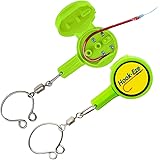Welcome to the world of bass fishing! If you’re looking for a thrilling and exciting activity, then look no further. Bass fishing is one of the most popular pastimes in America, and it’s easy to see why. With its combination of skill, strategy, and excitement, bass fishing offers something for everyone. In this article, we’ll explore some of the best places to go bass fishing in your state, as well as tips on how to catch big bass, what equipment to use, and more. Let’s get started!
Best Lures for Bass Fishing:
When it comes to bass fishing, having the right lure can make all the difference. There are many different types of lures available, each with their own unique features and benefits. Some of the most popular lures include crankbaits, spinnerbaits, jigs, and soft plastics. Crankbaits are great for covering lots of water quickly, while spinnerbaits are ideal for targeting specific areas. Jigs are perfect for working around cover, such as rocks or vegetation, while soft plastics are excellent for mimicking live bait. Ultimately, the choice of lure will depend on the individual angler’s preferences and the conditions they are fishing in.
Where to go Bass Fishing in Your State:
One of the first things that new bass anglers often want to know is where to go bass fishing in their state. The good news is that there are plenty of options available, regardless of where you live. Some states have famous lakes and rivers that are known for their abundant bass populations, such as Lake Fork in Texas or Lake St. Clair in Michigan. Other areas may offer smaller bodies of water that are just as productive, but less crowded. To find out about local hotspots, it’s always a good idea to talk to other anglers, read online reviews, or consult with a professional guide service.
Catching big bass requires a combination of skills and strategies. One key factor is knowing when and where to fish. For example, large bass tend to be more active during certain times of day, such as early morning or late afternoon. They also prefer certain types of habitat, such as deep ledges, rocky points, or thick vegetation. Once you’ve found a promising spot, it’s essential to present your lure in a way that appeals to the bass’s senses. This might involve using a particular retrieve rate or adding subtle twitches or pauses to your presentation. It’s also important to pay attention to the behavior of the fish and adjust your approach accordingly.
Equipment for Bass Fishing:
In order to succeed at bass fishing, it’s crucial to have the right equipment. This includes not only rods, reels, and lines but also accessories like hooks, weights, and floats. When choosing gear, it’s essential to consider factors such as line strength, rod action, and reel capacity. Anglers should also think about the type of fishing they plan to do, whether it’s from shore or a boat, and choose their equipment accordingly. Additionally, investing in high-quality clothing and accessories, such as polarized sunglasses or a comfortable pair of boots, can greatly enhance the overall experience.
What Lures to use for Bass Fishing:
As we mentioned earlier, there are many different types of lures available for bass fishing, each with their own unique characteristics. Some popular choices include crankbaits, spinnerbaits, jigs, and soft plastics. Crankbaits come in a variety of shapes and sizes, allowing anglers to cover lots of water quickly. Spinnerbaits feature a spinning blade that creates vibration and flash, making them an effective option for targeting specific areas. Jigs are versatile and can be fished in shallow or deep waters, while soft plastics provide a realistic representation of live bait. Ultimately, the decision of which lure to use will depend on several factors, including water clarity, depth, and time of year.
Teaching my child to Bass Fish:
For many parents, teaching their children to bass fish is a cherished tradition. Not only does it provide quality family time, but it also helps kids develop valuable life skills, such as patience, perseverance, and respect for nature. When introducing youngsters to bass fishing, it’s essential to start with basic concepts, such as casting, retrieving, and setting the hook. Using simple tackle and focusing on fun rather than catch numbers can help keep kids engaged and excited. As they progress, parents can introduce more advanced techniques, such as reading maps, identifying structure, and selecting appropriate lures. Before long, both parent and child will be enjoying the thrill of landing a trophy bass together.
Conclusion:
Bass fishing is a rewarding and fulfilling hobby that can be enjoyed by people of all ages and abilities. Whether you’re a beginner or an experienced pro, there’s always something new to learn or discover. By following these tips and tricks, you’ll be well on your way to becoming a successful bass angler. So grab your gear, hit the water, and get ready for the adventure of a lifetime!































































